 0
0
Hair Fall Preventive System
Is your hair or scalp problem worsening? Know the signs and treat the problem at its roots before its condition worsens.
A survey was conducted by Nathan Rich Research. It showed that men are more concerned with dandruff and scalp greasiness, while women tend to be more preoccupied with split ends and frizzy hair. However, both genders are worried about prominent hair partings and hair thinning. The survey also revealed that trichology and European herbal hair remedies are considered the most credible hair treatments. Majority of the respondents indicated TK TrichoKare as the “most trusted trichological centre”.Hair Loss
Hair loss occurs when the hair growth cycle is disrupted or when hair follicles are destroyed and replaced with scar tissue. It is usually caused by:
-
Family History (Hereditary)
Inheritance of baldness gene
-
Hormonal Changes
Presence of DHT in androgens, Childbirth, Menopause etc.
-
Stress
Can be either physical or mental stress
-
Diet
Low protein diet or a calorie-restricted diet lacking in balanced nutrients
-
Lifestyle
Excessive hair styling and hair treatments
-
Medical Condition/Medication
Thyroid, Diabetes, radiation, chemotherapy, medicine etc.
-
Age
As people age, their rate of hair growth slows
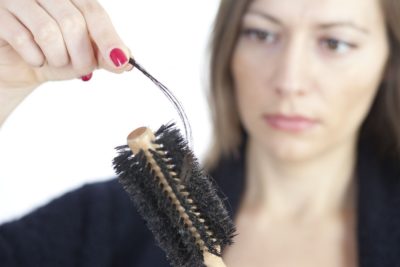
Oily Scalp
People who have oily skin are prone to having a greasy scalp with the possibility of scalp acne and pimples. Oily scalp is when overactive sebaceous glands produce excess oil. This excess oil attracts dirt and germs, which causes the scalp to itch.
Oily scalp is hereditary due to the hormone dihydrotestosterone (DHT), which can be reduced, but not eliminated.
Poor hygiene is also a contributing factor. When hair is not adequately shampooed or conditioned, the secreted oils on the scalp start to accumulate. Hair pores become susceptible to clogging, which prevents hair follicles from growing.
Environmental factors like hot weather, humidity and pollution can contribute to an oily scalp as well. For Singapore’s climate, you should wash your hair daily.
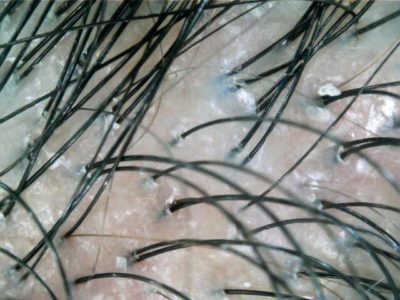
Sensitive Scalp
Like the skin on our face and body, our scalp can become sensitive too. It feels tight, dry, itchy and even painful, at times causing Dandruff to appear.
Change in climate or pollution and even stress generate free radicals. Free radicals modify the scalp’s structure and create changes in the hair bulb, developing this acute sensitivity.
Unsuitable hair products and harsh styling to the hair can cause the scalp to become sensitive as well. Some examples include hair perming and rebonding.
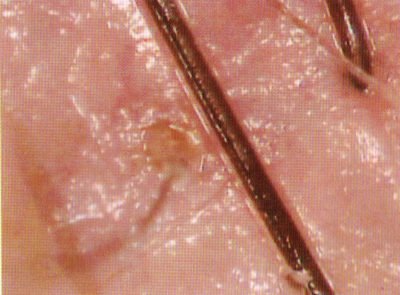
Dandruff
Skin cells are formed continuously on the scalp, which leads to the shedding of dead skin cells. This natural process happens every 20 to 28 days. Dandruff occurs when dead skin cells shed at a faster rate at every 7 to 10 days. Oil from the scalp causes the dead skin cells to clump together, and they appear as white flakes. Scalp redness and irritation are commonly associated with dandruff too.
Main sources of dandruff include environmental stress, humid weather, pollution, sensitive scalp, incorrect use of hair care products, and skin conditions or diseases like eczema, Malassezia etc.
Dandruff is treatable.
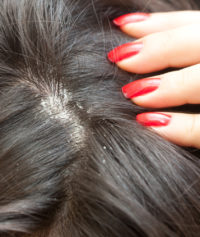
Aging Skin
As the name suggests, when we age, our scalps age as well and become thinner.
The lack of care leads to scalp sagging, loss of elasticity, grey hairs, hair thinning and balding. Our scalp is the fastest ageing skin. It ages 12x faster than body skin and 6x faster than the facial skin. The average speed of hair growth is at 1.25cm per month. However, on an ageing scalp, it slows down to by about 80%, growing at 0.25cm per month.
The underlying causes include a reduction in collagen level, fewer nutrient supplies, weak blood circulation, kidney or liver problem.
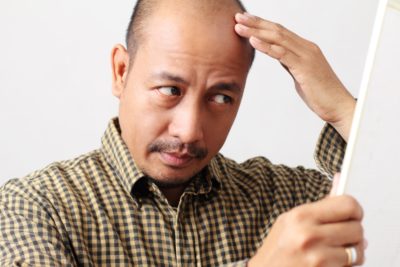
Greying Hair
Greying hair is one of the most apparent signs of ageing when the hair follicles produce fewer pigments called melanin. It often begins at the age of 30 and starts at the temples as it slowly extends to the top of the scalp.
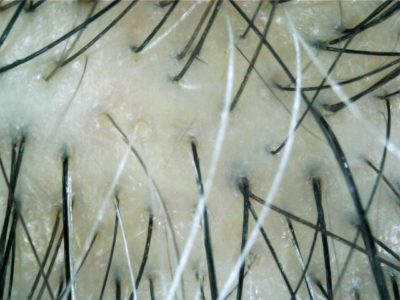
Other
Alopecia Totalis, Alopecia Universalis, Trichotillomania, Traction Alopecia, Folliculitis, Systematic Lupus Erythematosus etc.
FAQs
Why do we need to look after the scalp?
Many of us emphasise hair care and skincare, neglecting that scalp is a part of our skin. Scalp care is as vital as it deals with the root problem directly, where the hair is interlinked.
What are some ways to care for your scalp?
Regular maintenance treatments cleanse your scalp thoroughly. By attaining a healthy and deeply cleansed scalp, you can have healthy and beautiful hair.
What are the symptoms of an unhealthy scalp?
It varies on a case-by-case basis. Usually, we observed hair problems such as itchiness, dry hair, brittle hair, grey hair, acne-prone scalp, split ends, dandruff, greasy and flaky scalp.
If you have any hair & scalp problems and they are causing you distress, consult TrichoKare now or ask our Trichologists here!
“Your scalp is like the soil of a garden – you’re never going to grow beautiful flowers in unhealthy soil – just like you’re unlikely to have a full and healthy looking head of hair natured by an unhealthy scalp.”
Jane Ang I.A.T
Trichologist at TK TrichoKare
Member of International Association of Trichologists
Specialize in Hair and Scalp Problem
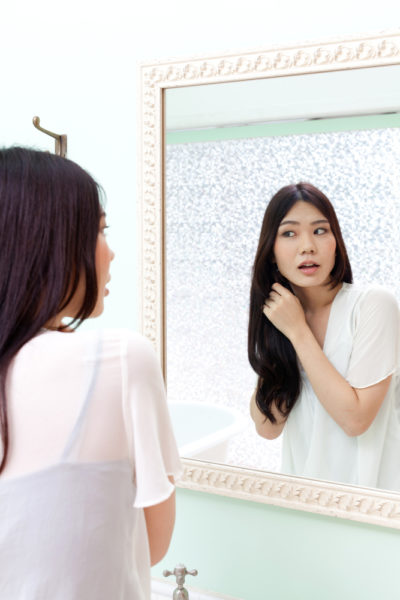
Additional Information
Hair fall is the first major symptom of hair loss. It is normal to lose about 50 – 100 strands of hair per day, regardless of your age. However, if there is excessive hair found on your pillow, toilet floor or a bunch of hair on the comb after using it, you should schedule for a check with our Trichologist.
Hair and scalp problems are easier to tackle during the early stages. Neglecting it could cause irreversible damage to hair follicles, leading to permanent hair loss.
A single healthy hair has a life span of 2 to 7 years. As the hair falls out, new hair will grow and replace it. Each hair shaft is equal in size with up to 3 strands of hair per pore. Hair thinning occurs when the density and diameter of the individual hair strand shrink, resulting in the hair to appear thin and limp. The hair follicle closes up until the hair becomes fine, causing the scalp to become visible.
Androgenic Alopecia is the most common form of hair loss for adults, affecting 70% of men and 40% of women.
Male pattern hair loss is frequently due to genes and male sex hormones. It affects 3 in 5 men and as early as age 20 to 30 years old. This typical pattern begins with the receding hairline until it forms an M shape. Gradually, it recedes to the crown and forms a horseshoe shape, before deteriorating quickly till most parts of the head are bald.
Female pattern hair loss is usually associated with ageing and hormonal changes. It is characterised by overall thinning of the hair on the scalp and does not lead to complete baldness.
Why do women lose hair?
Hair loss can be a frustrating experience for many women in this cosmopolitan society. Especially in this modern age, women have to juggle between career and family, which often leads to a stressful lifestyle.
What is female pattern hair loss?
Among women with hair loss problems, the most common type of problem is scientifically known as the Female Pattern Hair Loss. Not to be confused with the Male Pattern Hair Loss, the hair thins at the crown area and over the head while the frontal hairline is maintained. Generally, those with the Female Pattern Hair Loss experience more diffused and broader area of hair loss than those with Male Pattern Hair Loss.
Women can take advantage of long hair and fringe to hide their thinning problem. It is hard to recognise as it is not as visible. Nonetheless, it can be observed through a smaller ponytail, broader part line or excessive shedding when brushing and showering.
Women have a higher risk of hair problems with frequent chemical processing on their hair or having a lifestyle that causes an imbalance of hormones.
Women also face Post-Partum (after childbirth) hair loss. The movement of estrogen level in pregnancy is quite a toll on women. Estrogen level is the primary female sex hormones. It increases during pregnancy and slows down after birth before entering a resting phase. During this phase, many will experience tremendous hair loss. Post-natal hair fall is a temporary phase. Taking good care of your scalp can avoid a permanent hair loss situation.
Do you know?
- 40% of women have Female Pattern Hair Loss when they reach menopause./li>
- 90% female have significant thinning hair, based on a study conducted with TrichoKare existing customers.
- The word “shampoo” is derived from the Hindi “Champna” which mean to massage.
What is male pattern hair loss?
If you see a man with noticeable hair loss, chances are, he is suffering from the Male Pattern Hair Loss, also known as Androgenic Alopecia.
As the most prevalent type of hair loss amongst men, Male Pattern Hair Loss begins after puberty in the twenties. It then advances rapidly until all parts of the head, other than the sides and the back, become bald.
The male hormone, testosterone, is usually the cause of the Male Pattern Hair Loss. An enzyme found in skin cells and hair follicles converts this hormone into the more potent dihydrotestosterone (DHT).
DHT forms in the scalp and thins the hair at varying rates of speed, preventing blood circulation on your scalp.
Eventually, the hair follicles remain dormant as they are not replaced with new hair growth, resulting in hair loss.
Once Male Pattern Hair Loss is detected, you should seek hair care treatment as soon as possible to prevent irreversible hair loss. Once the hair follicles are dead, it is nearly impossible to grow hair from it again.
Do you know?
- Over 50% of men have Male Pattern Hair Loss by age 50, based on a study conducted with TrichoKare existing customers
- 90% of the hair on the scalp is growing, and 10% of it is resting.
- Hair is the fastest growing tissue in the body, second to bone marrow.
What is children hair loss?
There are many differences between children and adults in the causes of hair loss. It can be physiological, anatomical, cognitive, social or emotional.
Hair loss caused by genetics does not affect children as it will not show until a later age. Nonetheless, children can still experience hair loss like adults because of unbalanced diet, stress or improper hair care.
Alopecia Areata can occur at any age but most cases first develop in children and teenagers. Alopecia Areata is a disorder that causes sudden hair loss on the scalp due to stress. The body’s immune system attacks the hair follicles, causing hair loss. It is not permanent but may be psychologically damaging for children to cope with baldness.
Improper maintenance like neglecting protection against frizz and static cling, traction from a tight ponytail, or massive pulling of hair, are all possible factors of children hair loss. The epidermis in children is thinner and under-keratinized too, compared with adults. As a result, children are at risk from increased absorption of agents through the skin. Thus, shampoo should be carefully selected as children respond more rapidly to chemical shampoos.
Trichotillomania is another common cause of childhood alopecia. It is a form of traction hair loss caused by the compulsion to pull out their hair unconsciously, like while they are studying or distracted in their leisure time.
Do you know?
- Children face hair loss during their puberty stage, with girls starting at the age of 7 or 8 and boys at the age of 9.
- Hormonal changes during the puberty stage disrupt the hair growth cycle.
- Children have more sensitive scalps than adults.
This condition mainly appears among women and is reversible. With a significant increase in hair follicles entering the resting stage prematurely, this results in massive shedding. The main reason for this hair loss is due to drugs and medical treatments.
Alopecia Areata can be easily distinguished as the hair fall occurs in one or multiple circular/oval patches. It can be a temporary condition, yet at times it may spread to other parts of the body.
Alopecia Areata happens due to an abnormality in the immune system, which may cause one group of white blood cells to attack some of the cells of the hair bulb. Stress is another contributing factor; both physical and mental stress can induce such a condition.
Award-Winning Hair Fall Prevention Treatment
FREE ScalpBoost Ampoule(used during treatment), Hair Bath (Shampoo)(50ml), CompleteKare Mask (Conditioner)(50ml)
$49.90 Nett
(U.P. $745)
Book An Appointment
We'd love to hear from you! Send us a message and We will get back to you as soon as possible!
*Individual results may vary. There is no scientific proof that any product (except certain registered medicinal products) or service can retard hair loss or promote hair growth.
“Personal data obtained from the above information may be used for the purpose of making you aware of our services or promotions which TK TrichoKare thinks you may be interested in. Such information may also be disclosed to carefully selected third parties for direct marketing. If you wish to withdraw your consent given here in, you can do so at any time by sending an email to us or call us.”


